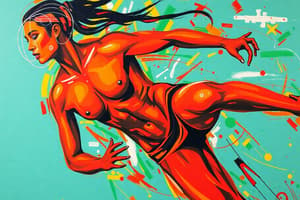Podcast
Questions and Answers
What concept emphasizes the importance of agency within power dynamics in physical culture?
What concept emphasizes the importance of agency within power dynamics in physical culture?
- Disciplinary power
- Relational power
- Power-over
- Power-to (correct)
Which aspect is central to understanding how identities are constructed within physical culture?
Which aspect is central to understanding how identities are constructed within physical culture?
- Biological determinism
- Globalization effects
- Individual preferences
- Socio-structural influences (correct)
What does the somatic turn primarily focus on?
What does the somatic turn primarily focus on?
- Economic factors in physical culture
- Agency of individuals in social practices
- Visual representation of bodies
- The body and embodiment in society (correct)
How does Physical Cultural Studies challenge existing norms?
How does Physical Cultural Studies challenge existing norms?
Which theoretical approach emphasizes the need to appreciate complexity within scholarship?
Which theoretical approach emphasizes the need to appreciate complexity within scholarship?
What is a key concern about the new positions of critical authority in academia as noted by King?
What is a key concern about the new positions of critical authority in academia as noted by King?
According to Adams, what is an essential role of feminism in academia?
According to Adams, what is an essential role of feminism in academia?
What concept does Rail advocate for in his view of scholarship?
What concept does Rail advocate for in his view of scholarship?
What does teaching as a political act imply according to the content?
What does teaching as a political act imply according to the content?
What challenge does the university face in the context of neoliberal constraints?
What challenge does the university face in the context of neoliberal constraints?
How does competitive pressure in academia relate to neoliberal values?
How does competitive pressure in academia relate to neoliberal values?
What does PCS risk by framing itself as a necessary evolution?
What does PCS risk by framing itself as a necessary evolution?
Which of the following statements correctly describes the impact of sports on societal identities?
Which of the following statements correctly describes the impact of sports on societal identities?
What was one of the main purposes of Kapernick's protest?
What was one of the main purposes of Kapernick's protest?
How does sport contribute to the reproduction of gender norms?
How does sport contribute to the reproduction of gender norms?
What challenges did Kapernick face as a result of his protest?
What challenges did Kapernick face as a result of his protest?
What is primarily challenged by the concept of a gender-free sport?
What is primarily challenged by the concept of a gender-free sport?
Which of the following is a potential benefit of transitioning from male-only baseball?
Which of the following is a potential benefit of transitioning from male-only baseball?
What is one effect of male dominance in sports-related professions?
What is one effect of male dominance in sports-related professions?
What does 'healthification' primarily focus on within sports spaces?
What does 'healthification' primarily focus on within sports spaces?
What overarching theme does the content suggest exists within sports?
What overarching theme does the content suggest exists within sports?
Which term best describes the process through which gendered differences are maintained in sports?
Which term best describes the process through which gendered differences are maintained in sports?
How does governmentality relate to the spaces of sport?
How does governmentality relate to the spaces of sport?
Which aspect is most likely excluded from traditional narratives about baseball?
Which aspect is most likely excluded from traditional narratives about baseball?
How do sports contribute to the understanding of race in society?
How do sports contribute to the understanding of race in society?
What role do sports organizations play in relation to gender norms?
What role do sports organizations play in relation to gender norms?
What does the creation of a counterculture in sports signify?
What does the creation of a counterculture in sports signify?
What role do institutions play in shaping interactions within sports?
What role do institutions play in shaping interactions within sports?
What does the term 'place' refer to in the context of sports?
What does the term 'place' refer to in the context of sports?
Which of the following is NOT a characteristic of healthified spaces in sports?
Which of the following is NOT a characteristic of healthified spaces in sports?
Flashcards
Physical Culture
Physical Culture
A complex and diverse set of activities and practices involving the body, influenced by social power structures and impacting how we understand ourselves and the world.
Power-over
Power-over
A form of power that involves domination and control, often institutionalized and enforced by law or authority.
Physical Cultural Studies (PCS)
Physical Cultural Studies (PCS)
An interdisciplinary field that examines how social, cultural, and political forces shape physical activities and experiences. It challenges dominant views within sports and fitness.
The Somatic Turn
The Somatic Turn
Signup and view all the flashcards
Reflexivity
Reflexivity
Signup and view all the flashcards
Neoliberalism in Academia
Neoliberalism in Academia
Signup and view all the flashcards
PCS (Postcolonial Studies)
PCS (Postcolonial Studies)
Signup and view all the flashcards
Political Engagement in Academia
Political Engagement in Academia
Signup and view all the flashcards
Teaching as a Political Act
Teaching as a Political Act
Signup and view all the flashcards
University as a Site of Activism
University as a Site of Activism
Signup and view all the flashcards
Nomadic Scholarship
Nomadic Scholarship
Signup and view all the flashcards
Liminality in Scholarship
Liminality in Scholarship
Signup and view all the flashcards
Sport and Myths
Sport and Myths
Signup and view all the flashcards
Ideals of White Supremacy in Sport
Ideals of White Supremacy in Sport
Signup and view all the flashcards
Kaepernick's Protest
Kaepernick's Protest
Signup and view all the flashcards
Sport and Politics
Sport and Politics
Signup and view all the flashcards
Counterpublic
Counterpublic
Signup and view all the flashcards
Dualist Gender Norms
Dualist Gender Norms
Signup and view all the flashcards
Reproduction of Femininity
Reproduction of Femininity
Signup and view all the flashcards
Male-Dominated Sports
Male-Dominated Sports
Signup and view all the flashcards
Gender Differences
Gender Differences
Signup and view all the flashcards
Occupational Injustice
Occupational Injustice
Signup and view all the flashcards
Binary-Normative Gender Order
Binary-Normative Gender Order
Signup and view all the flashcards
Cultural Texts
Cultural Texts
Signup and view all the flashcards
Hegemonic Masculinity
Hegemonic Masculinity
Signup and view all the flashcards
Counterculture
Counterculture
Signup and view all the flashcards
Trans-Inclusive
Trans-Inclusive
Signup and view all the flashcards
Destabilize Assumptions
Destabilize Assumptions
Signup and view all the flashcards
Intersectionality
Intersectionality
Signup and view all the flashcards
Governmentality
Governmentality
Signup and view all the flashcards
Study Notes
Course Key Concepts
- Physical Culture: Active, relational, and complex. Includes socio-structural, discursive, contextual, and collective aspects.
- Influences what is possible in physical culture and shapes constructions of identities.
- Physical Cultural Studies (PCS): Challenges dominant discourses in kinesiology, sport, and physical activity. Uses diverse theories and methods, grounded in real-world practices. Investigates how power operates in physical culture.
- Power: Power-over (institutionalized domination); Power-to (capacity for agency). Power shapes socio-historic conditions, social processes, and identities. Example: St. Jeromes (Indian Horse) and the Indian Act, showcasing government power over Indigenous communities.
- Physical Culture Sites: Spaces where power dynamics are played out, like sport centers and recreational areas. These sites reflect broader cultural and political forces.
- Foucault Insight: Encourages critical reflection on norms and practices by questioning their inherent assumptions.
- The Somatic turn: Focus shifts to the body in society, exploring its role in culture, consumerism, and daily life.
The Somatic turn
- How the body is central to culture, consumerism, and daily life.
- Modern Perspective: Body is seen as what it can do, not just what it is.
Reflexivity
- Researchers must examine their own positionality and influence on their studies.
- Theoretical frameworks shape research questions, methods, and interpretations.
Additional Concepts from Pages 2-10
- Helstein: Neoliberalism emphasizes complexity and difference in scholarship. Neoliberalism pressures scholars to adopt competitive and measurable values.
- King: Cautions about the unintended effects of critical approaches and frames. PCS positions risk marginalizing existing traditions.
- Adams: Political engagement is key, focusing on agency at various locations. Classrooms should foster political awareness.
- Rail: Advocates for humility and adaptability in diverse research.
- Jamieson: Focus is on utilizing different analytic frames to generate new knowledge. Productive conflict involves fission of perspectives, ideas, rather than new disciplines.
- Intersectional studies: Interconnected identities (e.g gender, race, class, sexuality, age) are analyzed. Categories are not isolated but are interconnected in shaping experiences of power. This framework recognizes that individuals hold multiple overlapping identities.
- Neoliberalism: Focuses on individual responsibility, productivity, privatization, and measurable outputs. It can marginalize marginalized groups, and critiques are evident.
- Methodologies: Qualitative research is often inductive, and constructivist/subjectivist, utilizing interpretivist methods to understand how people construct meaning in their lived experiences.
- Normativity: A focus on bodies. Normalcy is an absence of pathology. Normal is defined by existing cultures. This exclusionary perspective is based on assumptions from dominant cultures. Disciplining bodies by techniques of normalization and reproduction of normativity has a significant effect on the ability of others.
- Race and diversity in Kinesiology: An exploration of the outcomes of race and diversity in the discipline, its costs and benefits, problems, and issues related to inclusivity. Example: Racialized Minorities & Aboriginal students have little representation in curriculum.
- Kapernick's protest: Sport as a political act that has a visible impact.
- Gendered & Sexed Bodies: Gendered norms are produced, reproduced, and normalized. Women's entry into sport has been managed to conform to gender norms and expectations. Sports have become a source of norms and hegemonic masculinity and ideas about gender are evident in analysis of sports and sport practices. Gender creates social divides.
- Institutions: Rules shape behavior, production and interaction among people, and institutions often embody power relations and identity.
- Space (geography): Spaces are socially constituted, including health-focused spaces and facilities; often related to identity and health. Spaces are tied to emotion, and reflect social relations/hierarchies. Spaces are also political and often reproduce unequal access, based on identity (race, gender, class, ability)
- Geographical Imagination: Spaces are socially constructed, regulated, governed, and produced. Social relations, identities, health, and culture are shaped by spaces. Differing identities are assigned to differing spaces based on identity.
- Decentering the human: Consideration of the relationship between active human bodies and active non-human bodies.
- Environmental Managerialism: Minimal policies are enacted by governments with minimal impact on economic growth/environmental crises. This approach is often critiqued for inadequacy. Emphasis on integrating non-human actors into decision-making about environmental issues.
- Speciesism: Unjustified preference for humans over animals, leading to animal exploitation.
Studying That Suits You
Use AI to generate personalized quizzes and flashcards to suit your learning preferences.




